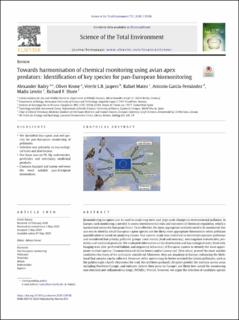| dc.contributor.author | Badry, Alexander | |
| dc.contributor.author | Krone, Oliver | |
| dc.contributor.author | Jaspers, Veerle | |
| dc.contributor.author | Mateo, Rafael | |
| dc.contributor.author | Garcia-Fernandez, Antonio | |
| dc.contributor.author | Leivits, Madis | |
| dc.contributor.author | Shore, Richard F. | |
| dc.date.accessioned | 2020-08-20T09:27:05Z | |
| dc.date.available | 2020-08-20T09:27:05Z | |
| dc.date.created | 2020-06-29T15:35:10Z | |
| dc.date.issued | 2020 | |
| dc.identifier.citation | Science of the Total Environment. 2020, 731 | en_US |
| dc.identifier.issn | 0048-9697 | |
| dc.identifier.uri | https://hdl.handle.net/11250/2673152 | |
| dc.description.abstract | Biomonitoring in raptors can be used to study long-term and large-scale changes in environmental pollution. In Europe, such monitoring is needed to assess environmental risks and outcomes of chemicals regulation, which is harmonised across the European Union. To be effective, the most appropriate sentinels need to be monitored. Our aim was to identify which European raptor species are the likely most appropriate biomonitors when pollutant quantification is based on analysing tissues. Our current study was restricted to terrestrial exposure pathways and considered four priority pollutant groups: toxic metals (lead and mercury), anticoagulant rodenticides, pesticides and medicinal products. We evaluated information on the distribution and key ecological traits (food web, foraging trait, diet, preferred habitat, and migratory behaviour) of European raptors to identify the most appropriate sentinel species. Common buzzard (Buteo buteo) and/or tawny owl (Strix aluco) proved the most suitable candidates for many of the pollutants considered. Moreover, they are abundant in Europe, enhancing the likelihood that samples can be collected. However, other species may be better sentinels for certain pollutants, such as the golden eagle (Aquila chrysaetos) for lead, the northern goshawk (Accipiter gentilis) for mercury across areas including Northern Europe, and vultures (where they occur in Europe) are likely best suited for monitoring non-steroidal anti-inflammatory drugs (NSAIDs). Overall, however, we argue the selection of candidate species for widescale monitoring of a range of pollutants can be reduced to very few raptor species. We recommend that the common buzzard and tawny owl should be the initial focus of any pan-European raptor monitoring. The lack of previous widespread monitoring using these species suggests that their utility as sentinels for environmnetal pollution has not been widely recognised. Finally, although the current study focussed on Europe, our trait-based approach for identifying raptor biomonitors can be applied to other continents and contaminants. | en_US |
| dc.language.iso | eng | en_US |
| dc.publisher | Elsevier | en_US |
| dc.rights | Attribution-NonCommercial-NoDerivatives 4.0 Internasjonal | * |
| dc.rights.uri | http://creativecommons.org/licenses/by-nc-nd/4.0/deed.no | * |
| dc.title | Towards harmonisation of chemical monitoring using avian apex predators: Identification of key species for pan-European biomonitoring | en_US |
| dc.type | Peer reviewed | en_US |
| dc.type | Journal article | en_US |
| dc.description.version | publishedVersion | en_US |
| dc.source.volume | 731 | en_US |
| dc.source.journal | Science of the Total Environment | en_US |
| dc.identifier.doi | https://doi.org/10.1016/j.scitotenv.2020.139198 | |
| dc.identifier.cristin | 1817657 | |
| dc.description.localcode | This article is available under the Creative Commons CC-BY-NC-ND license and permits non-commercial use of the work as published, without adaptation or alteration provided the work is fully attributed. | en_US |
| cristin.ispublished | true | |
| cristin.fulltext | original | |
| cristin.qualitycode | 2 | |

